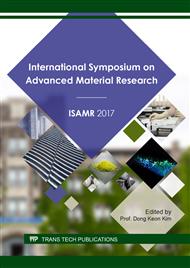[1]
B. Yan, C. Du, M. Xu, Liao, W. Liao, Decolorization of azo dyes by a salt-tolerant Staphylococcus cohnii strain isolated from textile wastewater, Front. Environ. Sci. Eng. China. 6(6) (2012) 806-814.
DOI: 10.1007/s11783-012-0453-4
Google Scholar
[2]
G. Liu, J. Zhou, Q. Ji, J. Wang, R. Jin, H. Lv, Accelerated removal of Sudan dye by Shewanella oneidensis MR-1 in the presence of quinones and humic acids, World J. Microbiol. Biotechnol. 29(9) (2013) 1723-1730.
DOI: 10.1007/s11274-013-1336-y
Google Scholar
[3]
R. G. Saratale, G. D. Saratale, J. S. Chang, S. P. Govindwar, Bacterial decolorization and degradation of azo dyes: a review, J. Taiwan. Int. Chem. Eng., 42(1) (2011) 138-157.
DOI: 10.1016/j.jtice.2010.06.006
Google Scholar
[4]
R. P. Singh, P. K. Singh, R. L. Singh, Bacterial Decolorization of Textile Azo Dye Acid Orange by Staphylococcus hominis RMLRT03, Toxicol. Int., 21(2) (2014) 160-166.
DOI: 10.4103/0971-6580.139797
Google Scholar
[5]
S. Moreira, A. M. F. Milarges, I. M. Solange, Reactive dyes and textile effluent decolorization by a mediator system of salt-tolerant laccase from Peniophora cinerea, Sep. Purif. Technol. 135 (2014) 183-189.
DOI: 10.1016/j.seppur.2014.08.017
Google Scholar
[6]
C. J. Ogugbue, T. Sawidis, N. A. Oranusi, Evaluation of colour removal in synthetic saline wastewater containing azo dyes using an immobilized halotolerant cell system, Ecol. Eng., 37(12) (2010) 2056-(2060).
DOI: 10.1016/j.ecoleng.2011.09.003
Google Scholar
[7]
EPA, Profile of the textile industry. Environmental Protection Agency, Washington, DC. (1997).
Google Scholar
[8]
M. A. Amoozegar, M. Hajighaseme, J. Hamedi, S. Asad, A. Ventosa, Azo dye decolorization by halophilic and halotolerant microorganisms, Ann. Microbiol., 61 (2010) 217-230.
DOI: 10.1007/s13213-010-0144-y
Google Scholar
[9]
S. Namwong, K. Hiraga, K. Takada, K. Tsunemi, S. Tanasupawat, K. Oda, A halophilic serine proteinase from Halobacillus sp. SR5-3 isolated from fish sauce: purification and characterization, Biosci. Biotechnol. Biochem., 70(6) (2006) 1395-1401.
DOI: 10.1271/bbb.50658
Google Scholar
[10]
S. Namwong, S. Tanasupawat, W. Visessanguan, T. Kudo, T. Itoh, Haloarcula salaria sp. nov. and Haloarcula tradensis sp. nov. from salt in fish sauce, Int. J. Syst. Evol. Microbiol. 61 (2011) 231-236.
DOI: 10.1099/ijs.0.021790-0
Google Scholar
[11]
S. Namwong, S. Tanasupawat, Identification of Staphylococcus strain CH1-8 and its oil-degradation, J. App. Phar. Sci., 4(11) (2014) 24-29.
Google Scholar
[12]
E. Franciscon, M. J. Crossman, J. A. Rizzato Paschoal, F. G. Reyes Reyes, L. D. Durrant, Decolorization and biodegradation of reactive sulfonated azo dyes by a newly isolated Brevibacterium sp. strain VN-15, SpringerPlus, 1(1) (2012) 37.
DOI: 10.1186/2193-1801-1-37
Google Scholar
[13]
L. G. Harris, S. J. Foster, R. G. Richards, An introduction to Staphylococcus aureus, and techniques for identifying and quantifying S. aureus adhesins in relation to adhesion to biomaterials: review, Eur Cell Mater. 4(2002) 39-60.
DOI: 10.22203/ecm.v004a04
Google Scholar
[14]
A. Khalid, M. Arshad, D. E. Crowley, Decolorization of azo dyes by Shewanella sp. under saline conditions, Appl. Microbiol. Biotechnol. 79(6) (2008) 1053-1059.
DOI: 10.1007/s00253-008-1498-y
Google Scholar
[15]
L. Kumari, A. K. Verma, D. Tiwary, D. D. Giri, G. Nath, P. K. Mishra, Biodegradation of Navy N5RL1 carpet dye by Staphylococcus saprophyticus strain BHUSSX3. 3, Biotechnol. 5(5) (2015) 775-782.
DOI: 10.1007/s13205-015-0276-7
Google Scholar
[16]
M. Mehdi, N. K. Nasser, B. K. Maryam, N. V. Nastaran, B. Ghodsieh, A. F. Mohammad, Immobilization of Laccase in Alginate-Gelatin Mixed Gel and Decolorization of Synthetic Dyes, Bioinor Chem. Appl. (2012) 1-7.
Google Scholar
[17]
A. A. Prasad, K. B. Rao, Aerobic biodegradation of azo dye Acid Black-24 by Bacillus halodurans, J. Environ. Biol. 35(3) (2014) 549-554.
Google Scholar
[18]
R. G. Saratale, G. D. Saratale, J. S. Chang, S. P. Govindwar, Decolorization and biodegradation of reactive dyes and dye wastewater by a developed bacterial consortium, Biodegradation. 21(6) (2010) 999-1015.
DOI: 10.1007/s10532-010-9360-1
Google Scholar
[19]
X. Meng, G. Liu, J. Zhou, Q. Shiang, Fu, G, Wang, Azo dye decolorization by Shewanella aquimarina under saline conditions, Bioresour. Technol. 114 (2012) 95-101.
DOI: 10.1016/j.biortech.2012.03.003
Google Scholar


